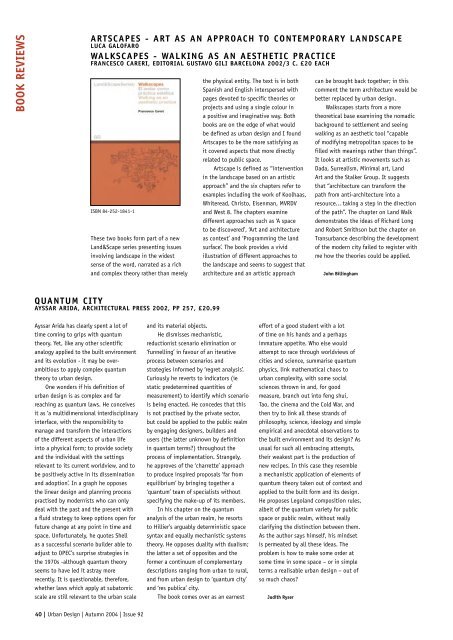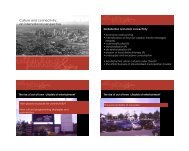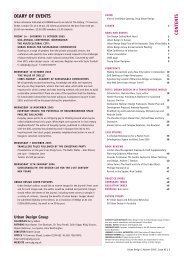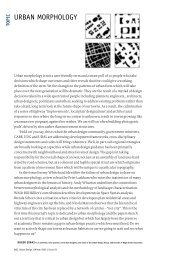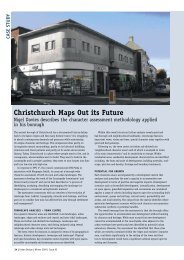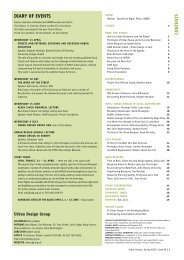topic - urban-design-group.org.uk
topic - urban-design-group.org.uk
topic - urban-design-group.org.uk
You also want an ePaper? Increase the reach of your titles
YUMPU automatically turns print PDFs into web optimized ePapers that Google loves.
BOOK REVIEWS<br />
ARTSCAPES - ART AS AN APPROACH TO CONTEMPORARY LANDSCAPE<br />
LUCA GALOFARO<br />
WALKSCAPES - WALKING AS AN AESTHETIC PRACTICE<br />
FRANCESCO CARERI, EDITORIAL GUSTAV0 GILI BARCELONA 2002/3 C. £20 EACH<br />
ISBN 84-252-1841-1<br />
These two books form part of a new<br />
Land&Scape series presenting issues<br />
involving landscape in the widest<br />
sense of the word, narrated as a rich<br />
and complex theory rather than merely<br />
the physical entity. The text is in both<br />
Spanish and English interspersed with<br />
pages devoted to specific theories or<br />
projects and using a single colour in<br />
a positive and imaginative way. Both<br />
books are on the edge of what would<br />
be defined as <strong>urban</strong> <strong>design</strong> and I found<br />
Artscapes to be the more satisfying as<br />
it covered aspects that more directly<br />
related to public space.<br />
Artscape is defined as “intervention<br />
in the landscape based on an artistic<br />
approach” and the six chapters refer to<br />
examples including the work of Koolhaas,<br />
Whiteread, Christo, Eisenman, MVRDV<br />
and West 8. The chapters examine<br />
different approaches such as ‘A space<br />
to be discovered’, ‘Art and architecture<br />
as context’ and ‘Programming the land<br />
surface’. The book provides a vivid<br />
illustration of different approaches to<br />
the landscape and seems to suggest that<br />
architecture and an artistic approach<br />
can be brought back together; in this<br />
comment the term architecture would be<br />
better replaced by <strong>urban</strong> <strong>design</strong>.<br />
Walkscapes starts from a more<br />
theoretical base examining the nomadic<br />
background to settlement and seeing<br />
walking as an aesthetic tool “capable<br />
of modifying metropolitan spaces to be<br />
filled with meanings rather than things”.<br />
It looks at artistic movements such as<br />
Dada, Surrealism, Minimal art, Land<br />
Art and the Stalker Group. It suggests<br />
that “architecture can transform the<br />
path from anti-architecture into a<br />
resource... taking a step in the direction<br />
of the path”. The chapter on Land Walk<br />
demonstrates the ideas of Richard Long<br />
and Robert Smithson but the chapter on<br />
Trans<strong>urban</strong>ce describing the development<br />
of the modern city failed to register with<br />
me how the theories could be applied.<br />
John Billingham<br />
QUANTUM CITY<br />
AYSSAR ARIDA, ARCHITECTURAL PRESS 2002, PP 257, £20.99<br />
Ayssar Arida has clearly spent a lot of<br />
time coming to grips with quantum<br />
theory. Yet, like any other scientific<br />
analogy applied to the built environment<br />
and its evolution - it may be overambitious<br />
to apply complex quantum<br />
theory to <strong>urban</strong> <strong>design</strong>.<br />
One wonders if his definition of<br />
<strong>urban</strong> <strong>design</strong> is as complex and far<br />
reaching as quantum laws. He conceives<br />
it as ‘a multidimensional interdisciplinary<br />
interface, with the responsibility to<br />
manage and transform the interactions<br />
of the different aspects of <strong>urban</strong> life<br />
into a physical form; to provide society<br />
and the individual with the settings<br />
relevant to its current worldview, and to<br />
be positively active in its dissemination<br />
and adoption’. In a graph he opposes<br />
the linear <strong>design</strong> and planning process<br />
practised by modernists who can only<br />
deal with the past and the present with<br />
a fluid strategy to keep options open for<br />
future change at any point in time and<br />
space. Unfortunately, he quotes Shell<br />
as a successful scenario builder able to<br />
adjust to OPEC’s surprise strategies in<br />
the 1970s -although quantum theory<br />
seems to have led it astray more<br />
recently. It is questionable, therefore,<br />
whether laws which apply at subatomic<br />
scale are still relevant to the <strong>urban</strong> scale<br />
and its material objects.<br />
He dismisses mechanistic,<br />
reductionist scenario elimination or<br />
‘funnelling’ in favour of an iterative<br />
process between scenarios and<br />
strategies informed by ‘regret analysis’.<br />
Curiously he reverts to indicators (ie<br />
static predetermined quantities of<br />
measurement) to identify which scenario<br />
is being enacted. He concedes that this<br />
is not practised by the private sector,<br />
but could be applied to the public realm<br />
by engaging <strong>design</strong>ers, builders and<br />
users (the latter unknown by definition<br />
in quantum terms?) throughout the<br />
process of implementation. Strangely,<br />
he approves of the ‘charrette’ approach<br />
to produce inspired proposals ‘far from<br />
equilibrium’ by bringing together a<br />
‘quantum’ team of specialists without<br />
specifying the make-up of its members.<br />
In his chapter on the quantum<br />
analysis of the <strong>urban</strong> realm, he resorts<br />
to Hillier’s arguably deterministic space<br />
syntax and equally mechanistic systems<br />
theory. He opposes duality with dualism;<br />
the latter a set of opposites and the<br />
former a continuum of complementary<br />
descriptions ranging from <strong>urban</strong> to rural,<br />
and from <strong>urban</strong> <strong>design</strong> to ‘quantum city’<br />
and ‘res publica’ city.<br />
The book comes over as an earnest<br />
effort of a good student with a lot<br />
of time on his hands and a perhaps<br />
immature appetite. Who else would<br />
attempt to race through worldviews of<br />
cities and science, summarise quantum<br />
physics, link mathematical chaos to<br />
<strong>urban</strong> complexity, with some social<br />
sciences thrown in and, for good<br />
measure, branch out into feng shui,<br />
Tao, the cinema and the Cold War, and<br />
then try to link all these strands of<br />
philosophy, science, ideology and simple<br />
empirical and anecdotal observations to<br />
the built environment and its <strong>design</strong>? As<br />
usual for such all embracing attempts,<br />
their weakest part is the production of<br />
new recipes. In this case they resemble<br />
a mechanistic application of elements of<br />
quantum theory taken out of context and<br />
applied to the built form and its <strong>design</strong>.<br />
He proposes Legoland composition rules,<br />
albeit of the quantum variety for public<br />
space or public realm, without really<br />
clarifying the distinction between them.<br />
As the author says himself, his mindset<br />
is permeated by all these ideas. The<br />
problem is how to make some order at<br />
some time in some space – or in simple<br />
terms a realisable <strong>urban</strong> <strong>design</strong> – out of<br />
so much chaos?<br />
Judith Ryser<br />
40 | Urban Design | Autumn 2004 | Issue 92


